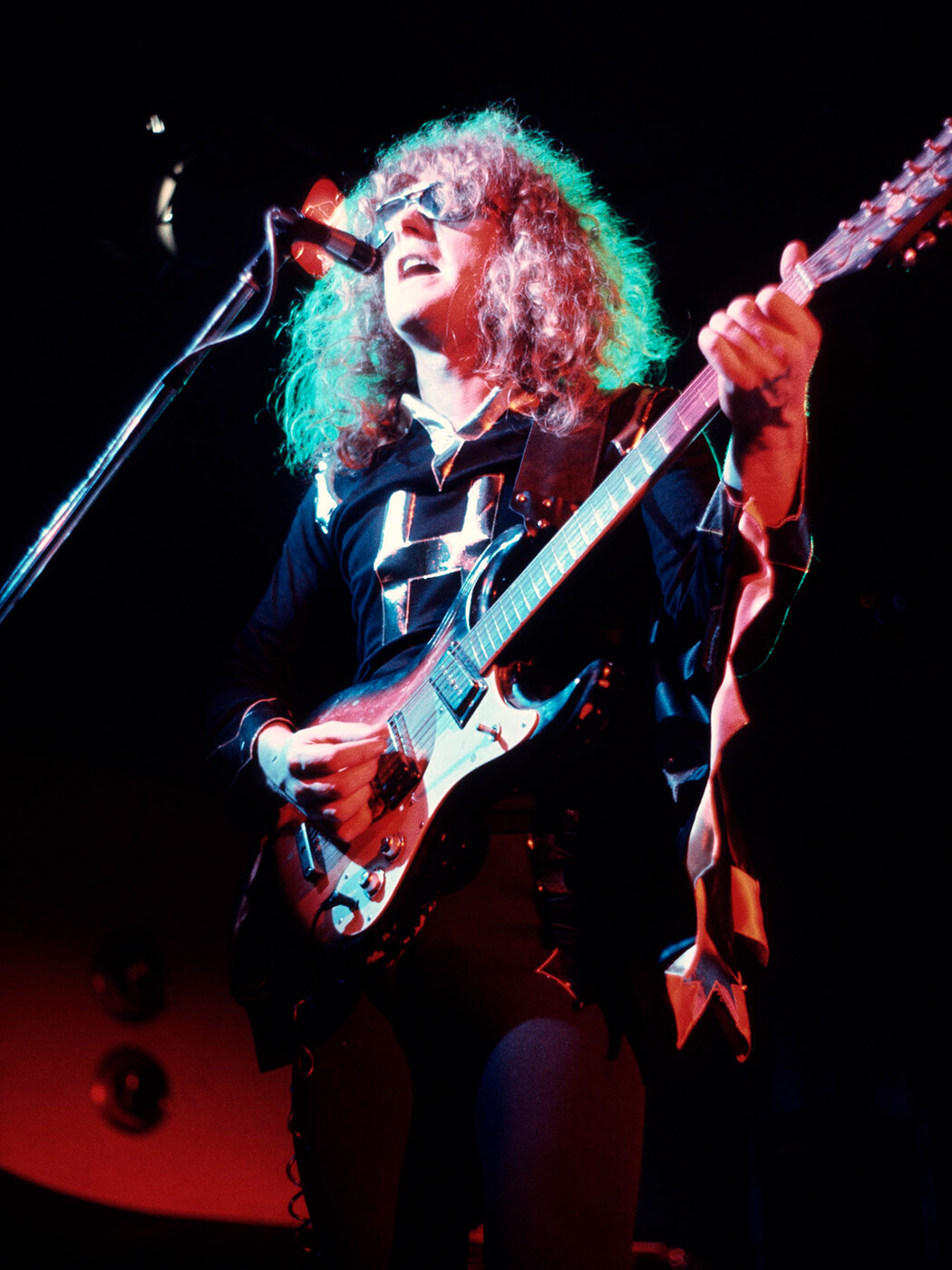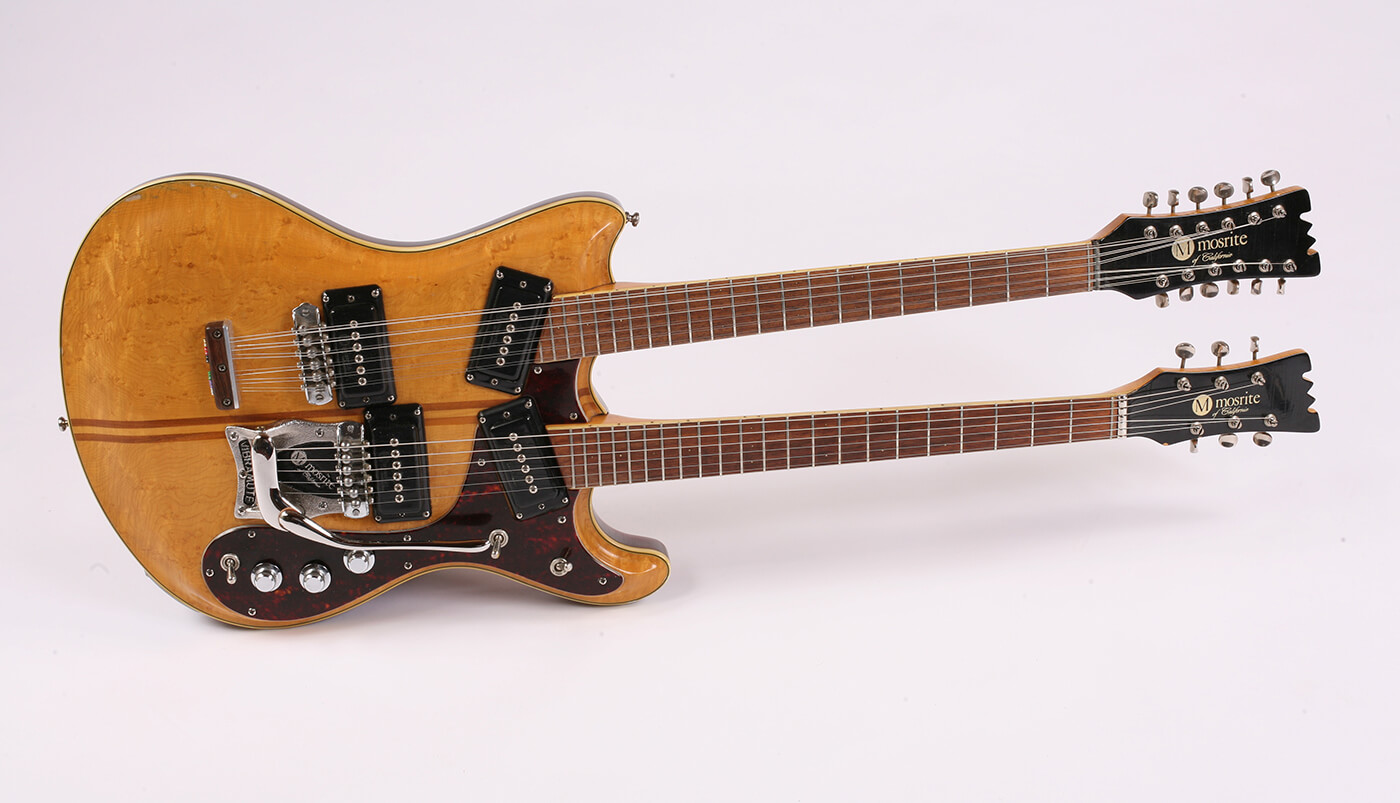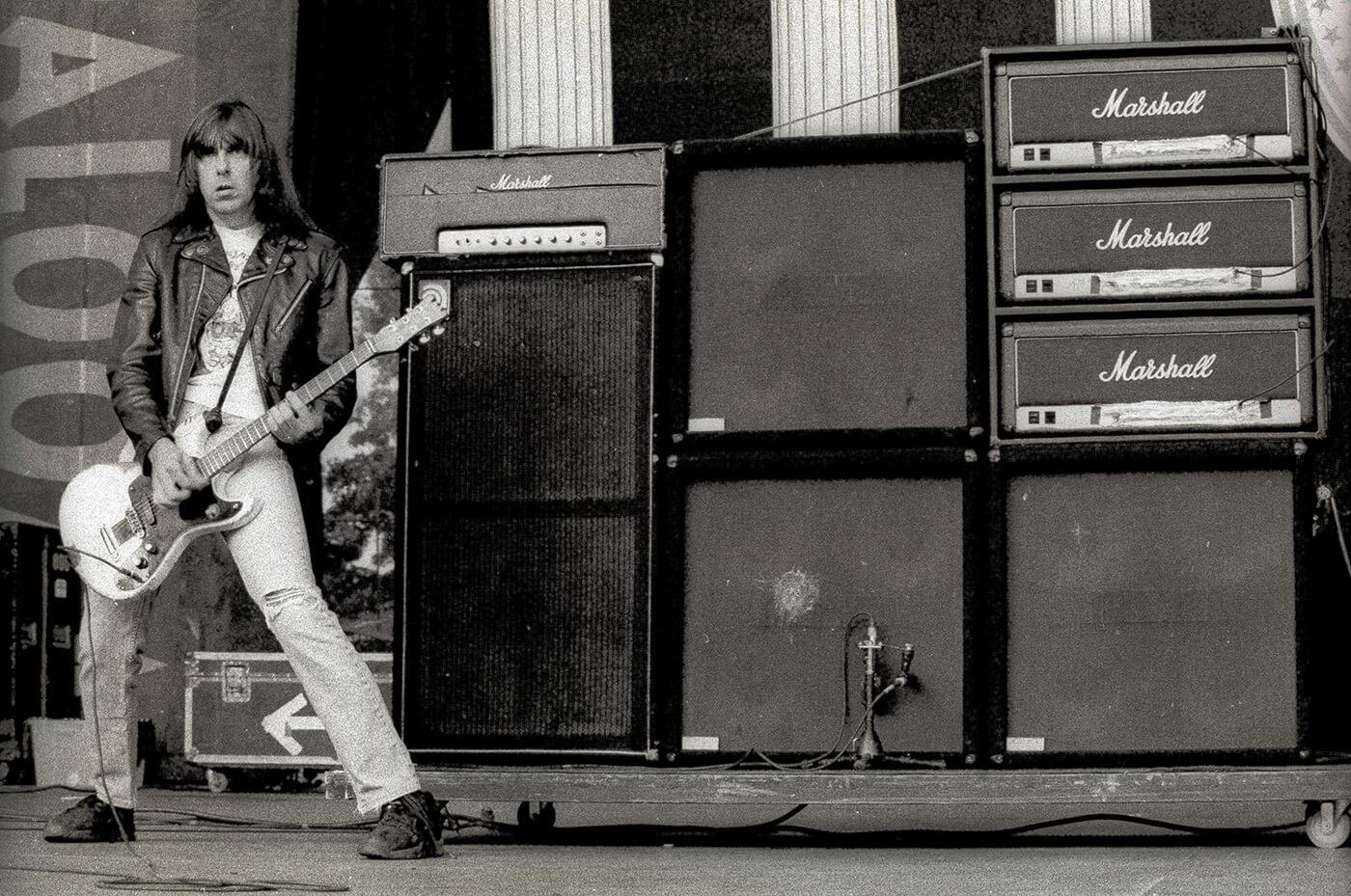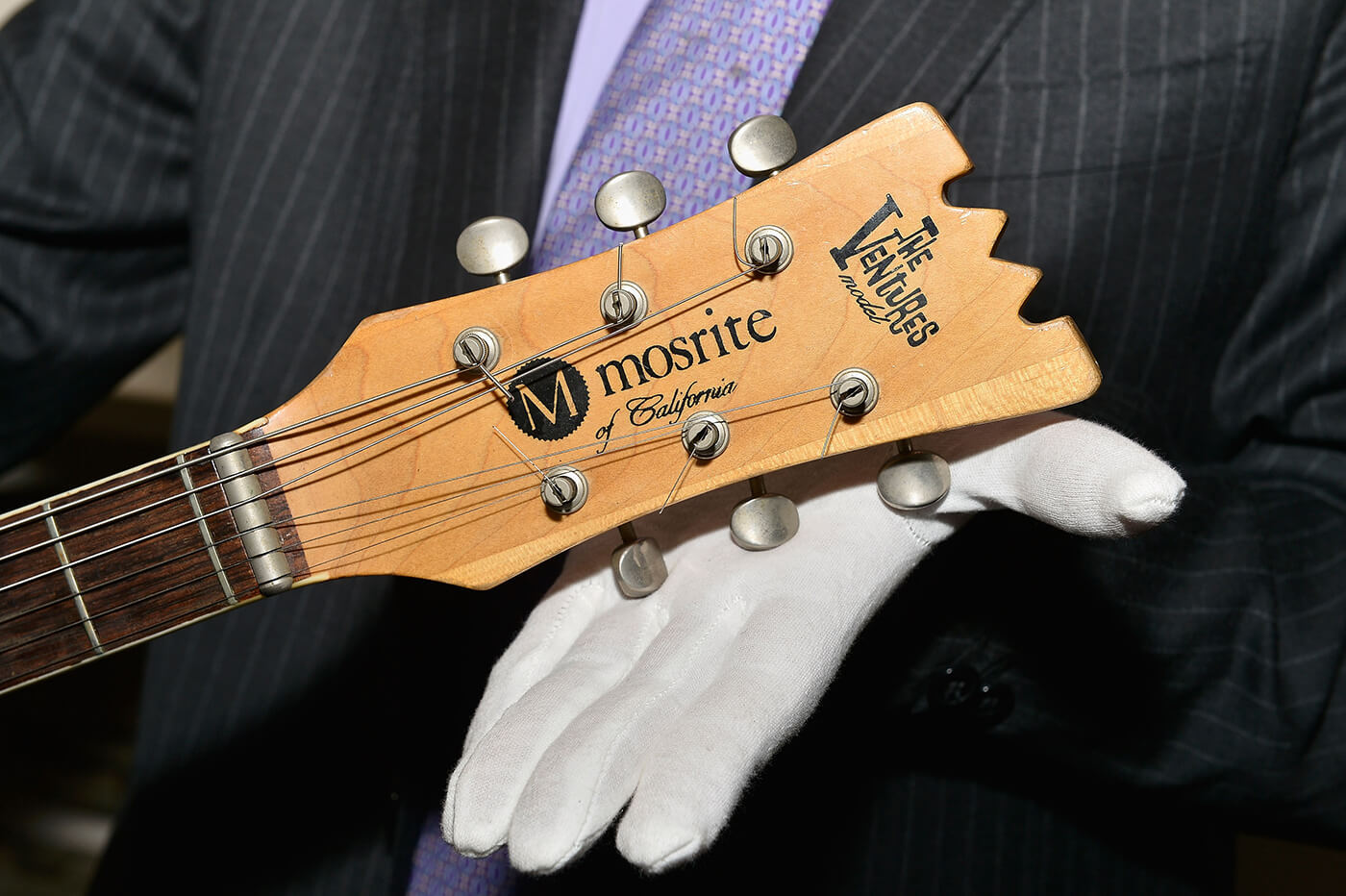Related Tags
A Brief History of Mosrite Guitars
Their unconventional shapes and hot pickups made Mosrite guitars a garage-rock icon, but it all started out in Semie Mosely’s garage.

Jonathan Horne from White Denim performs on the second day of the BBC 6 Music Festival at Colston Hall on February 13, 2016 in Bristol, England. Image: Adam Gasson/Redferns/Getty Images
They’re some of the most distinctive and unique instruments of the Golden Age of guitars, but Mosrite guitars had an unremarkable beginning, being founded in 1956 in Bakersfield California by a man named Semie Moseley.
Moseley was born in Oklahoma and moved west when he was just a few years old, first to Arizona and then to Bakersfield. Semie Moseley was a fairly accomplished musician in his own right, having played guitar in an evangelical church group since the age of 13.
From a very early age, he and his brother, Andy, would often build their own guitars in their childhood home. In time, Semie became more fascinated with building guitars rather than playing them.
In 1952, Moseley got what must have been the dream job for a young man obsessed with guitars – an apprenticeship at Rickenbacker in Los Angeles. A couple of years after Semie arrived, another guitar builder joined the ranks of Rickenbacker – Roger Rossmeisl.
Rossmeisl, as you may know, was a brilliant instrument designer from Germany who would go on to create iconic models for Rickenbacker such as the 300 series guitars and 4000 and 4001 series bass guitars, and would later move to Fender where he designed the Coronado, Thinline Telecaster, Wildwood, and LTD models.
Rossmeisl, who had been schooled in luthiery by some of Germany’s finest artisans, clearly had a significant impact on Moseley, as many of the designs Semie created later on featured the ‘German carve’ – the trademark chamfered edge that Rossmeisl used on several guitar designs (including the Combo and the 318).

It wasn’t just one genius Semie was learning from however – while he was working at Rickenbacker, he also apprenticed with Paul Bigsby, in Downey, California. Bigsby of course, is the man who made the first modern solid-body guitar for Merle Travis in 1948, and also designed the vibrato system that bears his name to this day. Southern California was an absolute mecca of guitar innovation during this era.
All the while he was apprenticing with these great builders, he would come home and build guitars in his garage that were as weird as they were wonderful. In 1954 he built a triple neck instrument with one standard scale neck, a shorter scale neck tuned one octave up, and the third neck was an eight-string mandolin.
Multi-neck guitars became something of a specialty for Moseley and he would also build double-neck guitars for Joe Maphis and Larry Collins. Before long, word started getting around about his guitars as they were appearing on television from time to time. Moseley was well known for inlaying the guitar players’ name into the fretboard, as was the style for many country western musicians at the time – Paul Bigsby did it for Merle Travis on that famous first electric solidbody.

By 1956, Moseley and his brother Andy had found someone to bankroll a new guitar company, Reverend Ray Boatright, a local Los Angeles Foursquare Gospel minister – the resulting company was called Mosrite, a combination of the Moseley and Boatright names. Moseley was still working at the Rickenbacker factory and when he began sharing the good news that he was going to launch his own company, he was fired.
According to a book titled Bakersfield Sound, the brothers started out hand-building custom guitars for artists and in 1959, Andy moved to Nashville to market their guitars to the country western crowd, As Andy recalled, “We sold a few to Grand Ole Opry people, and to road musicians, and that’s how we kept the factory going at the time: custom guitars.”
The company’s big break came from back on the west coast, with The Ventures, specifically, lead guitarist, Nokie Edwards. Edwards fell in love with his Mosrite guitar, and by 1962, he had convinced the entire Seattle-based band to play custom Mosrites on songs like Walk, Don’t Run and the theme from Hawaii Five-O.

The guitars became synonymous with the band – they even signed a special distribution agreement with Mosrite and featured the guitars on their album covers. In turn, Mosrite put The Ventures name on their guitars. The Ventures were wildly popular in Japan and this created world-wide demand for the guitars. The Ventures line started in 1963 and ran through 1967 or 1968 when the licensing agreement ended.
At the peak of production in 1968, Semie, his brother Andy and their crew of 107 employees were said to be producing around 1000 guitars per month – acoustics, standard electrics, double-necks, triple-necks, basses, dobros, even mandolins. The Sears & Roebuck Co. offered one million dollars to buy out Mosrite, but Moseley turned it down.
He and Andy also branched off into recording with Mosrite Records, which would release records by a variety of artists, but none made much of a lasting impact. Andy focused on the record label and Semie remained with the guitar company.
In 1968, it was time to ink a new distribution deal and they decided to go with Thomas Organ Company, who had their own line of guitars to market. In retrospect, Andy, says he regrets trusting distribution to a competitor. The company went bankrupt within a year after signing the deal. Following the bankruptcy, the Moseley’s tried to deal directly with stores, and they sold 280 guitars in 1969 before falling into bankruptcy.

Two years later, Semie was able to get the rights to the Mosrite name back, and in 1970 he started making guitars again in Pumpkin Center, California. But as great as he was at building guitars, he wasn’t a great businessman and he ended up moving his factory three times in the next 20 years: to Oklahoma City, Oklahoma, in the mid-70s, to Jonas Ridge, North Carolina in 1981, and to Booneville, Arkansas in 1991.
It was in this post-bankruptcy period, ironically, that many of Mosrite’s most visible users would come to the fore. In the mid-70s The Ramones became standard-bearers for the nascent New York punk scene, and guitarist Johnny Ramone would never be seen without his trusty Mosrite.
The brand’s combination of quirky looks and good build quality meant that many other notable guitarists would pick up a Mosrite over the course of the following decades – from Kurt Cobain and Jerry Cantrell to Robert Smith and Rory Gallagher.
Sadly, six months after moving to Arkansas Semie became ill with bone cancer, and died just six weeks later in August 1992. His long-time business partner also died suddenly, and even more shockingly – in 1990, Reverend Ray Boatright was attacked outside his church in Watts. He was holding a Mosrite model that had been made specifically for him by Semie, called the Gospel model (Kurt Cobain played a few of these in the early days). The guitar was smashed and Boatright was killed in the attack.

It fell to Semie’s daughter, Dana Moseley, to carry on the family trade, and she continued to build custom Mosrite guitars in small numbers for new owners Fillmore, which produced American Mosrite guitars in Las Vegas and more affordable versions in the Tokai factor in Japan.
Sadly, the current ownership and status of Mosrite is in flux – the website went offline in 2020, and the previous dealer that sold their guitars, Ed Roman in Vegas, no longer lists any new Mosrite instruments on its website. If history is anything to go by, however, we haven’t seen the last of Mosrite guitars.
